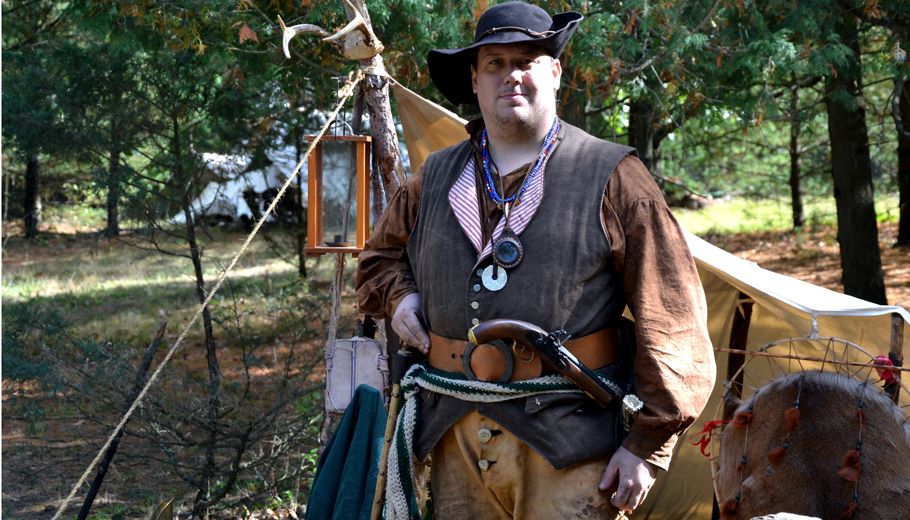
Deep-woods tradition in New London
By James Card
The sweet stink of blackpowder filled the autumn air and tomahawks sliced through falling leaves before thunking into wooden targets.
For the past 36 years, the Fox Valley Muzzleloaders have held the Capote Classic Rendezvous in early October.
A capote is a wrapped wool coat with a hood that was common dress during the years of the North American fur trade. There were also called “blanket coats.” Many people wore capotes during the rendezvous, along with buckskin pants and leather moccasins.
“We named it the capote classic because at this time of year it feels good,” said Brain Bradley, the club’s secretary who was dressed in one and sat by a small fire. It was a cool day that hinted of colder days to come.
The club originally hosted two rendezvous per year. One was in July and after a while club members bagged the sweltering summer event.
Established in 1960 in the Fox River Valley area, the initial club members met in their homes and leased range land by Black Creek until they acquired 40 wooded acres four miles south of New London in the 1970s. The club currently has 42 members.
Celebrating Wisconsin’s frontier heritage
According to club rules, anyone can dress anyway they want if they want to compete in the muzzleloader shooting events. However, if they want to camp in the primitive campsite area, they are encouraged to dress the part. The part to be reenacted is that of the voyagers, trappers and pioneers of early Wisconsin history.
There are two campsite areas, a modern one with recreational vehicles, campers and tubular tents and then back among an open grove of pine and oak trees are canvas wall tents, tepees and lean-tos. It is a place where food is cooked upon cast iron and people lounge on Viking chairs covered with deerskins.
“The Great Lakes fur trade started in the 1600s. It was mostly Native Americans that trapped the furs and went to the fur posts around the Great Lakes and Canada. They shipped everything to Montreal, and then shipped to Europe. That was the era of voyagers were out and paddling their canoes. That lasted from the late 1600s to 1835 or 1840 until silk hats came out and they didn’t want the beaver fur anymore. That was a long time,” said Bradley.
“The western mountain man stuff that you see on movies and TV, that was only 20 years. That’s all that lasted. That was only a poof in history compared to the Great Lakes fur trade and the Canadian fur trade. People don’t realize that,” he said.
Bradley is writing grants for a building fund. Their plan is to replace their current clubhouse for a larger one to host teaching seminars and to be the home to a fully furnished blacksmith shop.
The clubhouse is simple and rustic. Inside are picnic tables, a woodstove, a lunch counter and a kitchen area. On the walls were black-and-white photos and maps showing the early explorations of North America.
They had a silent auction and up for bid were custom tomahawks, stag-handled knives, a cast-iron wash stand, a .41-caliber Mississippi derringer, a horn flask, a braided belt bag, a set of enamel cookware, camp kitchen chuck box and a range box.
Taking aim
Not far from the clubhouse was the firing line. The shooters took aim at paper targets featuring a buffalo adorned with black bull’s-eye. They were the official targets of the National Muzzle Loading Rifle Association.
Near the clubhouse is a stone plaque mounted on a boulder that officially chartered the club with the NMLRA.
Throughout the year they host shoots and some of them are themed, such as one for shooting pistols or smoothbores loaded with birdshot for smoking clay pigeons.
The shooting range has backstop berms at 25, 50 and 100 yards and one small berm at 10 yards.
“That is generally use for pistol shooting at close range,” said club president Jeff Anderson.
“We also have a Woods Walk with 13 steel gong targets with a naturally formed ridge behind those for shooting safety and we also have a knife and tomahawk throw at stump targets and also an archery target. That’s separate competition this weekend. That’s traditional to these rendezvous events. In the early 1800s it was something the free trappers and mountain men would do when they would get together,” he said.
According to Anderson, there is a resurgence of blackpowder rifle builders who are making high-end rifles using CNC technology that are far more accurate than rifles from a couple decades ago. The wood stocks can be custom ordered according to grade and the rifles can be ordered completely finished or as a do-it-yourself kit.
“There is a strong movement and a lot of people are getting interested so a lot of this stuff is getting backordered,” said Anderson.
Gearing up for this sport is easy enough through online shopping. No federal firearms license transfer is needed for blackpowder firearms and they can be shipped to your door. Buying blackpowder itself is trickier since there are laws pertaining to the shipping and storage of explosive material.
“In this area, it’s in downtown Lomira. Bill’s Sporting Goods. He typically has blackpowder in stock. You’ll probably end up buying 3F. Probably three-quarters or better of traditional muzzleloaders use triple F. It’s a granular measure in how fine or coarse the powder is,” said Anderson.
To learn more about the club visit www.foxvalleymuzzleloaders.com.
